CADILLAC ESCALADE ESV 2010 Owners Manual
Manufacturer: CADILLAC, Model Year: 2010, Model line: ESCALADE ESV, Model: CADILLAC ESCALADE ESV 2010Pages: 620, PDF Size: 7.4 MB
Page 541 of 620
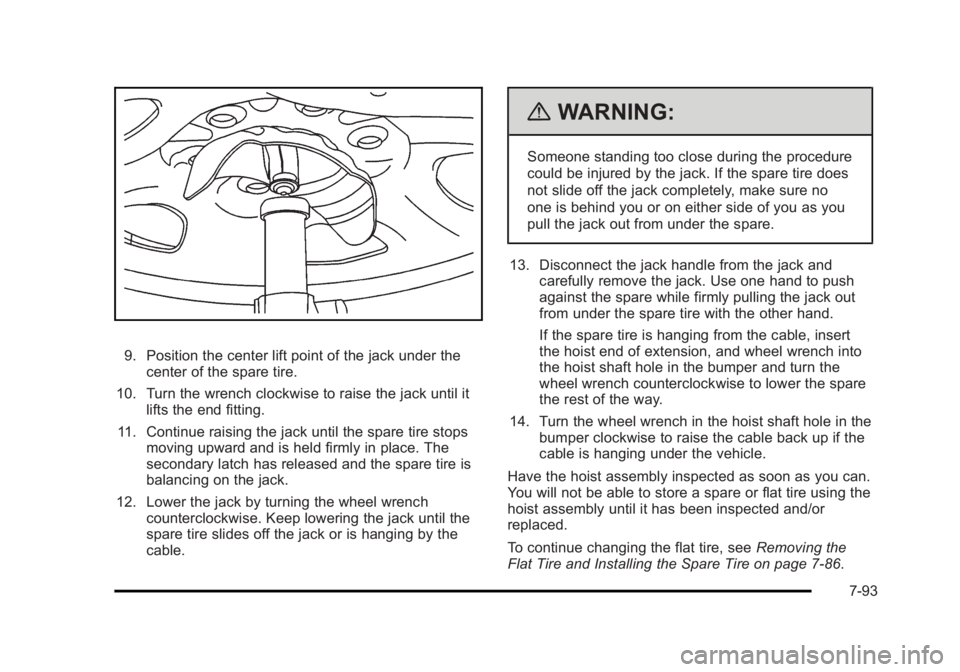
Black plate (93,1)Cadillac Escalade/Escalade ESV Owner Manual - 2010
9. Position the center lift point of the jack under the
center of the spare tire.
10. Turn the wrench clockwise to raise the jack until it
lifts the end fitting.
11. Continue raising the jack until the spare tire stops
moving upward and is held firmly in place. The
secondary latch has released and the spare tire is
balancing on the jack.
12. Lower the jack by turning the wheel wrench
counterclockwise. Keep lowering the jack until the
spare tire slides off the jack or is hanging by the
cable. { WARNING: Someone standing too close during the procedure
could be injured by the jack. If the spare tire does
not slide off the jack completely, make sure no
one is behind you or on either side of you as you
pull the jack out from under the spare.
13. Disconnect the jack handle from the jack and
carefully remove the jack. Use one hand to push
against the spare while firmly pulling the jack out
from under the spare tire with the other hand.
If the spare tire is hanging from the cable, insert
the hoist end of extension, and wheel wrench into
the hoist shaft hole in the bumper and turn the
wheel wrench counterclockwise to lower the spare
the rest of the way.
14. Turn the wheel wrench in the hoist shaft hole in the
bumper clockwise to raise the cable back up if the
cable is hanging under the vehicle.
Have the hoist assembly inspected as soon as you can.
You will not be able to store a spare or flat tire using the
hoist assembly until it has been inspected and/or
replaced.
To continue changing the flat tire, see Removing the
Flat Tire and Installing the Spare Tire on page 7 ‑ 86 .
7-93
Page 542 of 620
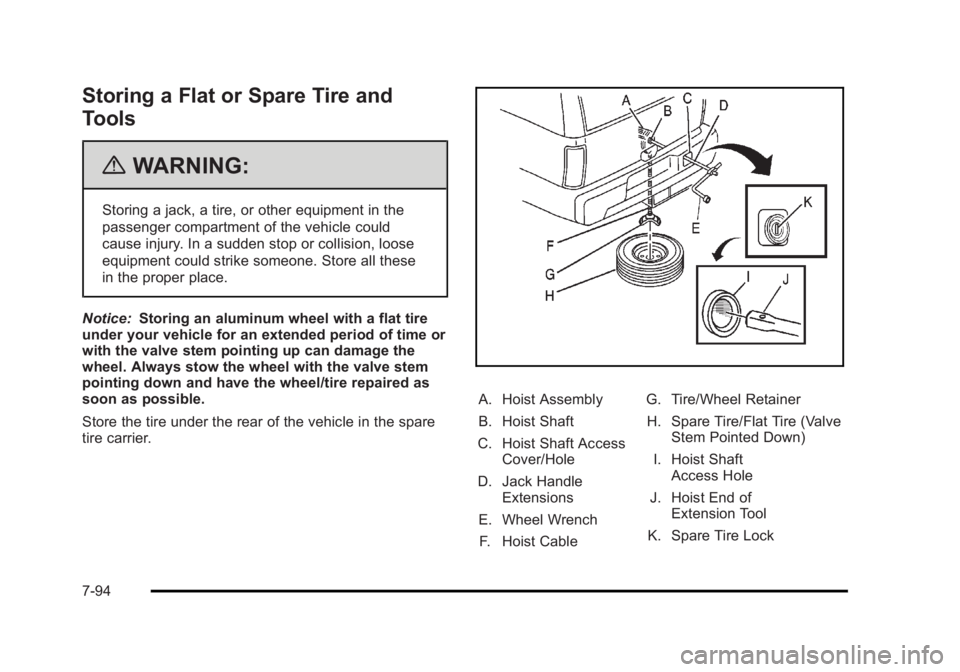
Black plate (94,1)Cadillac Escalade/Escalade ESV Owner Manual - 2010
Storing a Flat or Spare Tire and
Tools
{ WARNING: Storing a jack, a tire, or other equipment in the
passenger compartment of the vehicle could
cause injury. In a sudden stop or collision, loose
equipment could strike someone. Store all these
in the proper place.
Notice: Storing an aluminum wheel with a flat tire
under your vehicle for an extended period of time or
with the valve stem pointing up can damage the
wheel. Always stow the wheel with the valve stem
pointing down and have the wheel/tire repaired as
soon as possible.
Store the tire under the rear of the vehicle in the spare
tire carrier. A. Hoist Assembly
B. Hoist Shaft
C. Hoist Shaft Access
Cover/Hole
D. Jack Handle
Extensions
E. Wheel Wrench
F. Hoist Cable G. Tire/Wheel Retainer
H. Spare Tire/Flat Tire (Valve
Stem Pointed Down)
I. Hoist Shaft
Access Hole
J. Hoist End of
Extension Tool
K. Spare Tire Lock
7-94
Page 543 of 620
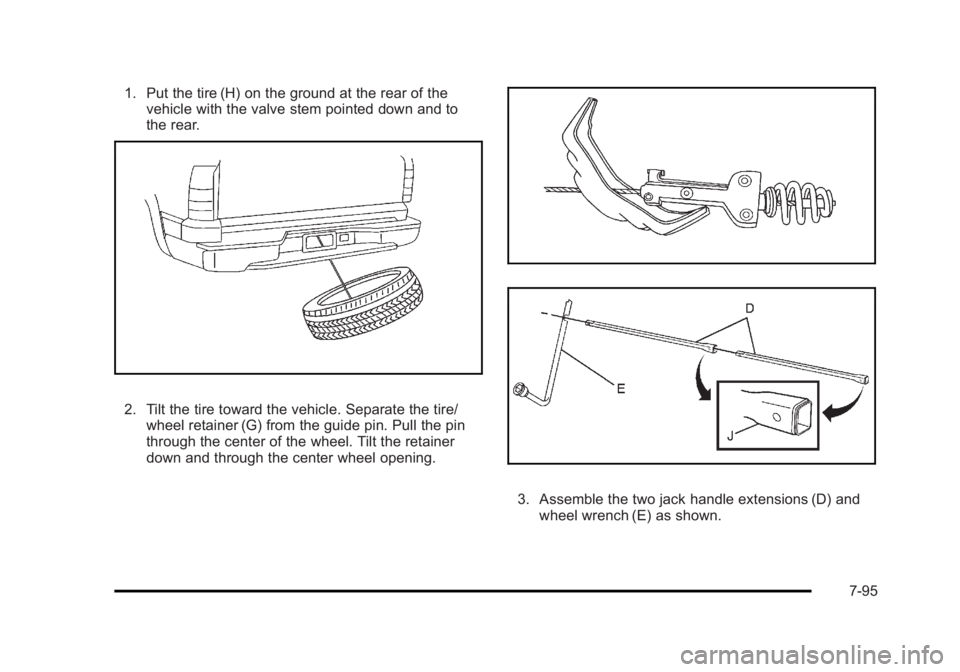
Black plate (95,1)Cadillac Escalade/Escalade ESV Owner Manual - 2010
1. Put the tire (H) on the ground at the rear of the
vehicle with the valve stem pointed down and to
the rear.
2. Tilt the tire toward the vehicle. Separate the tire/
wheel retainer (G) from the guide pin. Pull the pin
through the center of the wheel. Tilt the retainer
down and through the center wheel opening.
3. Assemble the two jack handle extensions (D) and
wheel wrench (E) as shown.
7-95
Page 544 of 620
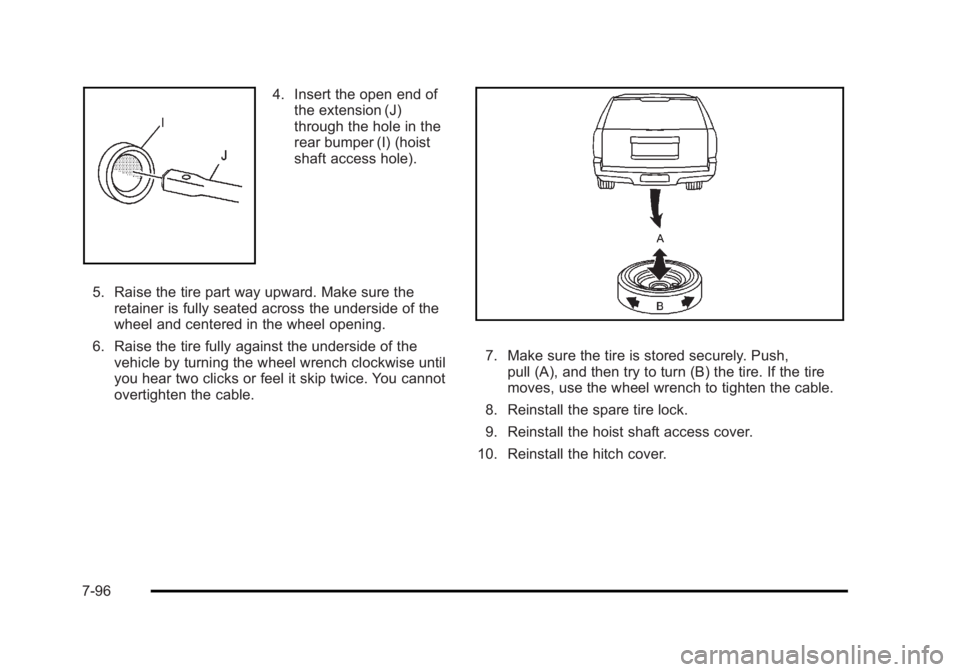
Black plate (96,1)Cadillac Escalade/Escalade ESV Owner Manual - 2010
4. Insert the open end of
the extension (J)
through the hole in the
rear bumper (I) (hoist
shaft access hole).
5. Raise the tire part way upward. Make sure the
retainer is fully seated across the underside of the
wheel and centered in the wheel opening.
6. Raise the tire fully against the underside of the
vehicle by turning the wheel wrench clockwise until
you hear two clicks or feel it skip twice. You cannot
overtighten the cable. 7. Make sure the tire is stored securely. Push,
pull (A), and then try to turn (B) the tire. If the tire
moves, use the wheel wrench to tighten the cable.
8. Reinstall the spare tire lock.
9. Reinstall the hoist shaft access cover.
10. Reinstall the hitch cover.
7-96
Page 545 of 620
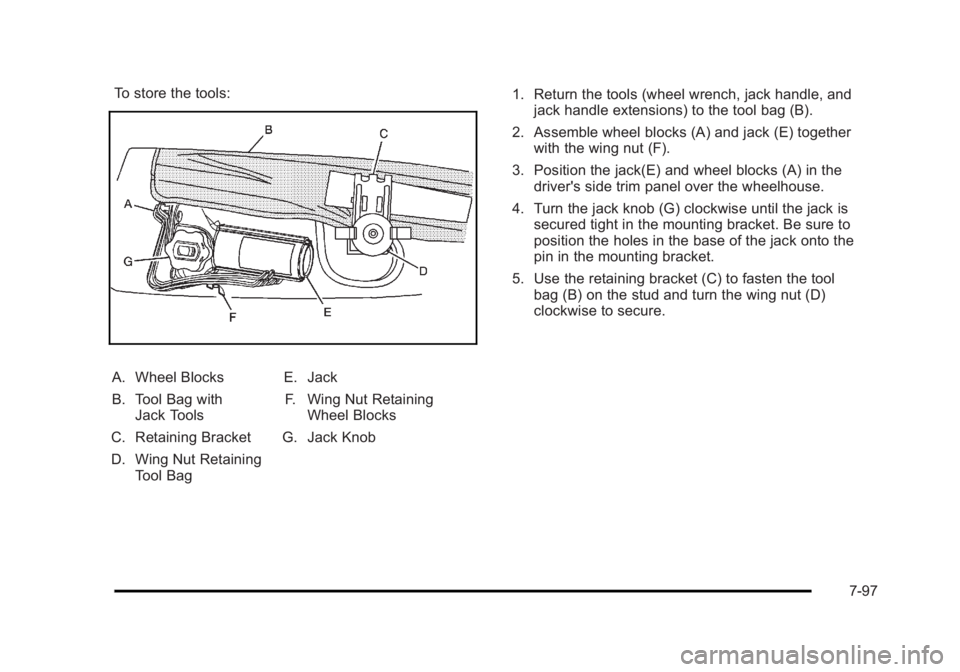
Black plate (97,1)Cadillac Escalade/Escalade ESV Owner Manual - 2010
To store the tools:
A. Wheel Blocks
B. Tool Bag with
Jack Tools
C. Retaining Bracket
D. Wing Nut Retaining
Tool Bag E. Jack
F. Wing Nut Retaining
Wheel Blocks
G. Jack Knob 1. Return the tools (wheel wrench, jack handle, and
jack handle extensions) to the tool bag (B).
2. Assemble wheel blocks (A) and jack (E) together
with the wing nut (F).
3. Position the jack(E) and wheel blocks (A) in the
driver's side trim panel over the wheelhouse.
4. Turn the jack knob (G) clockwise until the jack is
secured tight in the mounting bracket. Be sure to
position the holes in the base of the jack onto the
pin in the mounting bracket.
5. Use the retaining bracket (C) to fasten the tool
bag (B) on the stud and turn the wing nut (D)
clockwise to secure.
7-97
Page 546 of 620

Black plate (98,1)Cadillac Escalade/Escalade ESV Owner Manual - 2010
Regular Wheelbase shown, Extended Wheelbase
similar.
6. Return the storage tray to its original stored
position. Spare Tire Your vehicle, when new, had a fully-inflated spare tire.
A spare tire may lose air over time, so check its inflation
pressure regularly. See Inflation - Tire Pressure
on
page 7 ‑ 65 and Loading the Vehicle on page 6 ‑ 32 for
information regarding proper tire inflation and loading
your vehicle. For instruction on how to remove, install or
store a spare tire, see Removing the Flat Tire and
Installing the Spare Tire
on page 7 ‑ 86 and Storing a
Flat or Spare Tire and Tools on page 7 ‑ 94 .
After installing the spare tire on your vehicle, you should
stop as soon as possible and make sure the spare is
correctly inflated. The spare tire is made to perform well
at speeds up to 70 mph (112 km/h) at the recommended
inflation pressure, so you can finish your trip.
Have the damaged or flat road tire repaired or replaced
as soon as you can and installed back onto your
vehicle. This way, a spare tire will be available in case
you need it again. Do not mix tires and wheels of
different sizes, because they will not fit. Keep your
spare tire and its wheel together.
7-98
Page 547 of 620

Black plate (99,1)Cadillac Escalade/Escalade ESV Owner Manual - 2010
Appearance Care Interior Cleaning The vehicle's interior will continue to look its best if
it is cleaned often. Although not always visible, dust
and dirt can accumulate on the upholstery. Dirt can
damage carpet, fabric, leather, and plastic surfaces.
Regular vacuuming is recommended to remove
particles from the upholstery. It is important to keep
the upholstery from becoming and remaining heavily
soiled. Soils should be removed as quickly as possible.
The vehicle's interior may experience extremes of heat
that could cause stains to set rapidly.
Lighter colored interiors may require more frequent
cleaning. Use care because newspapers and garments
that transfer color to home furnishings may also transfer
color to the vehicle's interior.
When cleaning the vehicle's interior, only use cleaners
specifically designed for the surfaces being cleaned.
Permanent damage may result from using cleaners on
surfaces for which they were not intended. Use glass
cleaner only on glass. Remove any accidental
over-spray from other surfaces immediately. To prevent
over-spray, apply cleaner directly to the cleaning cloth. Notice: Using abrasive cleaners when cleaning
glass surfaces on the vehicle, could scratch the
glass and/or cause damage to the rear window
defogger. When cleaning the glass on the vehicle,
use only a soft cloth and glass cleaner.
Many cleaners contain solvents that may become
concentrated in the vehicle's breathing space.
Before using cleaners, read and adhere to all safety
instructions on the label. While cleaning the vehicle's
interior, maintain adequate ventilation by opening the
vehicle's doors and windows.
Dust may be removed from small buttons and knobs
using a small brush with soft bristles.
Products that remove odors from the vehicle's
upholstery and clean the vehicle's glass can be
obtained from your dealer.
Do not clean the vehicle using: .
A knife or any other sharp object to remove a soil
from any interior surface. .
A stiff brush. It can cause damage to the vehicle's
interior surfaces. .
Heavy pressure or aggressive rubbing with a
cleaning cloth. Use of heavy pressure can damage
the interior and does not improve the effectiveness
of soil removal.
7-99
Page 548 of 620

Black plate (100,1)Cadillac Escalade/Escalade ESV Owner Manual - 2010 .
Laundry detergents or dishwashing soaps with
degreasers can leave residue that streaks and
attracts dirt. For liquid cleaners, about 20 drops per
gallon (3.78 L) of water is a good guide. Use only
mild, neutral-pH soaps. .
Too much cleaner that saturates the upholstery. .
Organic solvents such as naptha, alcohol, etc. that
can damage the vehicle's interior.
Fabric/Carpet Use a vacuum cleaner with a soft brush attachment
frequently to remove dust and loose dirt. A canister
vacuum with a beater bar in the nozzle may only be
used on floor carpet and carpeted floor mats. For any
soil, always try to remove it first with plain water or club
soda. Before cleaning, gently remove as much of the
soil as possible using one of the following techniques: .
For liquids: gently blot the remaining soil with a
paper towel. Allow the soil to absorb into the paper
towel until no more can be removed. .
For solid dry soils: remove as much as possible
and then vacuum. To clean:
1. Saturate a lint-free, clean white cloth with water or
club soda.
2. Wring the cloth to remove excess moisture.
3. Start on the outside edge of the soil and gently rub
toward the center. Continue cleaning, using a clean
area of the cloth each time it becomes soiled.
4. Continue to gently rub the soiled area until the
cleaning cloth remains clean.
5. If the soil is not completely removed, use a mild
soap solution and repeat the cleaning process that
was used with plain water.
If any of the soil remains, a commercial fabric cleaner or
spot lifter may be necessary. When a commercial
upholstery cleaner or spot lifter is to be used, test a
small hidden area for colorfastness first. If the locally
cleaned area gives any impression that a ring formation
may result, clean the entire surface.
After the cleaning process has been completed, a paper
towel can be used to blot excess moisture from the
fabric or carpet.
7-100
Page 549 of 620
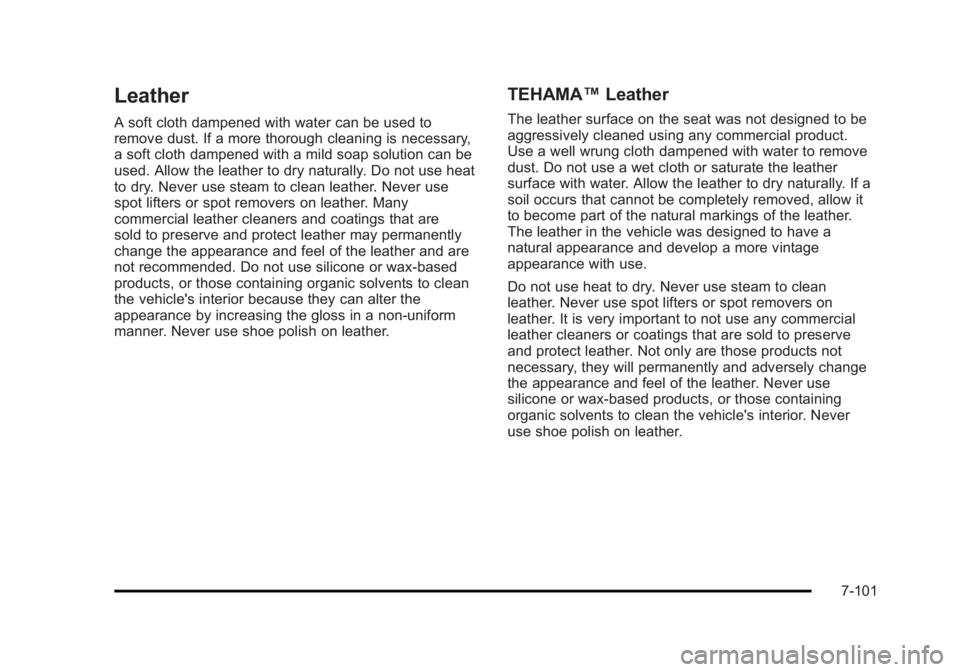
Black plate (101,1)Cadillac Escalade/Escalade ESV Owner Manual - 2010
Leather A soft cloth dampened with water can be used to
remove dust. If a more thorough cleaning is necessary,
a soft cloth dampened with a mild soap solution can be
used. Allow the leather to dry naturally. Do not use heat
to dry. Never use steam to clean leather. Never use
spot lifters or spot removers on leather. Many
commercial leather cleaners and coatings that are
sold to preserve and protect leather may permanently
change the appearance and feel of the leather and are
not recommended. Do not use silicone or wax-based
products, or those containing organic solvents to clean
the vehicle's interior because they can alter the
appearance by increasing the gloss in a non-uniform
manner. Never use shoe polish on leather. TEHAMA ™ Leather The leather surface on the seat was not designed to be
aggressively cleaned using any commercial product.
Use a well wrung cloth dampened with water to remove
dust. Do not use a wet cloth or saturate the leather
surface with water. Allow the leather to dry naturally. If a
soil occurs that cannot be completely removed, allow it
to become part of the natural markings of the leather.
The leather in the vehicle was designed to have a
natural appearance and develop a more vintage
appearance with use.
Do not use heat to dry. Never use steam to clean
leather. Never use spot lifters or spot removers on
leather. It is very important to not use any commercial
leather cleaners or coatings that are sold to preserve
and protect leather. Not only are those products not
necessary, they will permanently and adversely change
the appearance and feel of the leather. Never use
silicone or wax-based products, or those containing
organic solvents to clean the vehicle's interior. Never
use shoe polish on leather.
7-101
Page 550 of 620
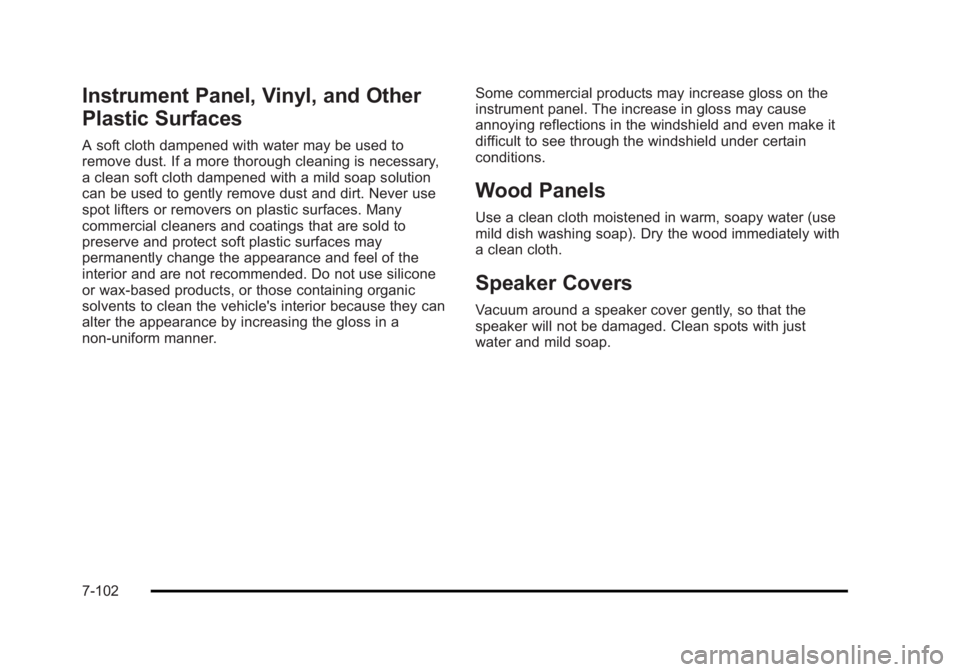
Black plate (102,1)Cadillac Escalade/Escalade ESV Owner Manual - 2010
Instrument Panel, Vinyl, and Other
Plastic Surfaces A soft cloth dampened with water may be used to
remove dust. If a more thorough cleaning is necessary,
a clean soft cloth dampened with a mild soap solution
can be used to gently remove dust and dirt. Never use
spot lifters or removers on plastic surfaces. Many
commercial cleaners and coatings that are sold to
preserve and protect soft plastic surfaces may
permanently change the appearance and feel of the
interior and are not recommended. Do not use silicone
or wax-based products, or those containing organic
solvents to clean the vehicle's interior because they can
alter the appearance by increasing the gloss in a
non-uniform manner. Some commercial products may increase gloss on the
instrument panel. The increase in gloss may cause
annoying reflections in the windshield and even make it
difficult to see through the windshield under certain
conditions.
Wood Panels Use a clean cloth moistened in warm, soapy water (use
mild dish washing soap). Dry the wood immediately with
a clean cloth.
Speaker Covers Vacuum around a speaker cover gently, so that the
speaker will not be damaged. Clean spots with just
water and mild soap.
7-102